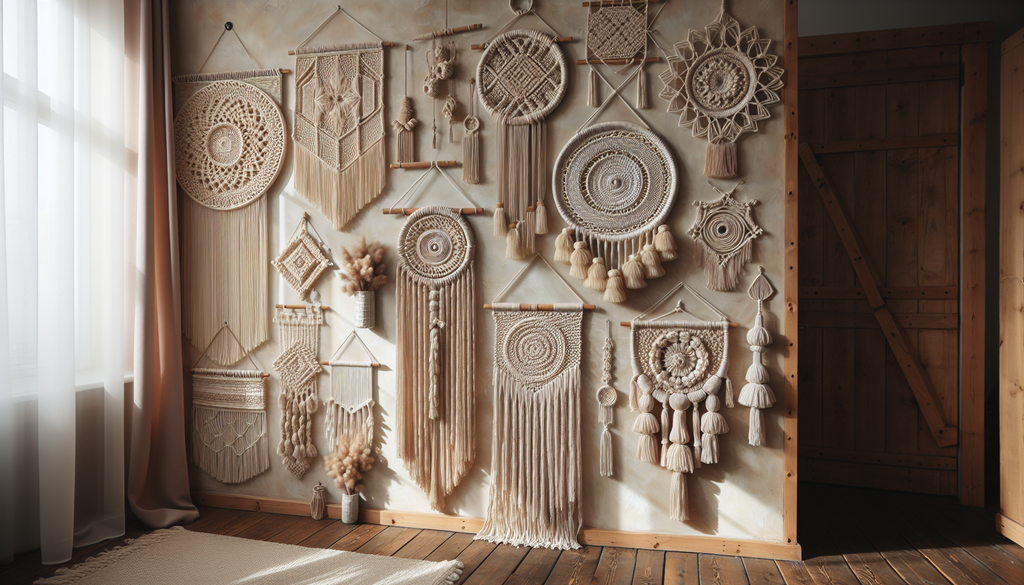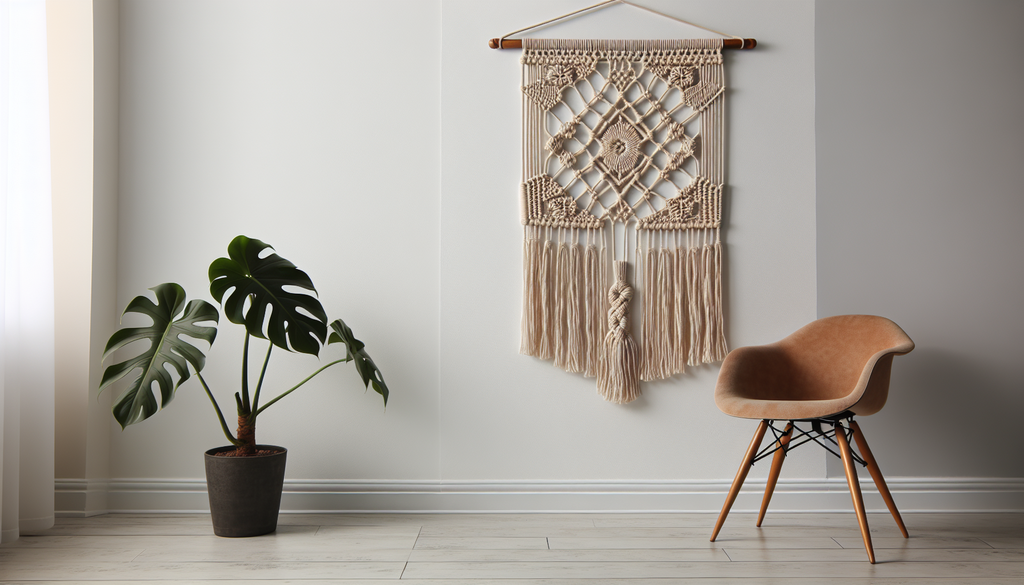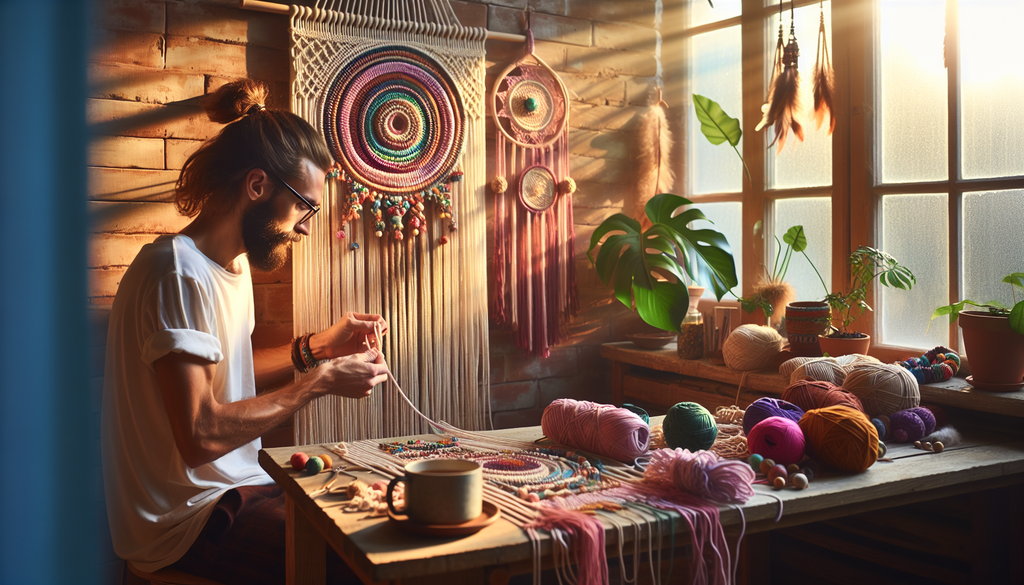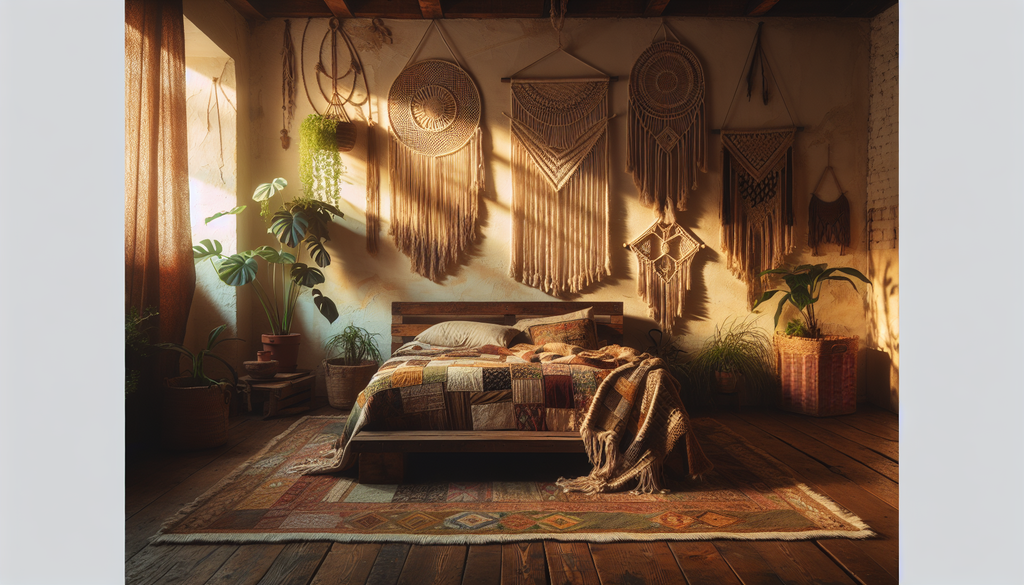Discover how the modern macramé movement is entwining the past with present-day style and sustainability. As this craft re-emerges, it caters to a desire for artisanal authenticity and eco-conscious living. Our guide will take you through its history and how it’s being transformed by contemporary artists into a versatile and stylish element of today’s homes and fashion.
Key Takeaways
-
Macramé is making a huge comeback, fueled by a desire for sustainable, handcrafted goods and a throwback to simpler, artistic pursuits. It’s an ancient practice with a modern spin, now intertwined with social media and eco-consciousness.
-
Modern macramé combines traditional techniques with contemporary styles, creating versatile items for home décor, fashion, and accessories. It caters to aesthetic preferences, offering various textures and personal expression through the craft.
-
The macramé community is thriving, with numerous resources for learners, a vibrant social media presence, and artists gaining recognition through collaborative projects and exhibitions. Online platforms and social influencers play a big role in its modern resurgence.
The Resurgence of Macramé
Loved by the bohemians of the 1970s and now embraced by millennials, macramé is experiencing a renaissance. The craft has seen periods of popularity throughout history, each surge reflecting the zeitgeist of the time. The 1970s saw a major surge when macramé was associated with the bohemian lifestyle and used to create a wide array of items, from wall hangings to jewelry.
Today, it’s back with a modern twist, riding the wave of a back-to-basics approach and integrating with modern technology and social media platforms. The beauty of macramé lies not just in its visual appeal but also in its rich history and evolution.
Origins and Evolution
Macramé is an ancient craft, its roots tracing back to civilizations such as China, Babylon, and the Assyrian Empire, where it was further developed by 13th-century Arab weavers. The term ‘macramé’ comes from the Arabic ‘migramah,’ suggesting references to decorative or fringed textiles. This craft was introduced into Europe following the Moorish conquest.
The Victorian era saw macramé gain widespread popularity in Europe, specifically with the release of ‘Sylvia’s Book of Macramé Lace’ in 1882. Sailors played a pivotal role in macramé's global dispersion, sharing and trading their macramé creations, which led to its presence in the Americas and China. This historical journey of macramé, from ancient civilizations to your modern living room, adds a layer of depth to every knot and twist.
Reasons for Revival
The resurgence of macramé among younger generations is partly due to a higher valuation of artisanal skills and the pursuit of sustainable lifestyle choices. The invention of ‘macraweave’ has broadened the scope of macramé by incorporating weaving techniques, resulting in a rise in popularity due to increased design possibilities.
Macramé's adaptability as a decorative element enables it to fit various home décor styles, furthering its modern revival. Its handcrafted nature imbues it with sentimental value, a stark contrast to the impersonality of mass-produced items, further bolstering its appeal in the current era. This revival is not just about fashion trends or nostalgia; it’s a nod to sustainable living, a celebration of artisanal skills, and a testament to human creativity.
Modern Macramé Patterns and Styles
 Modern macramé artists have taken traditional knots and patterns and reimagined them into more contemporary designs, infusing creativity and personal flair. Traditional macramé patterns have been adapted to create more geometric, clean-lined styles, catering to modern aesthetic preferences. These patterns can range from simple, repetitive designs to complex arrangements, which are increasingly being used to enhance home décor.
Modern macramé artists have taken traditional knots and patterns and reimagined them into more contemporary designs, infusing creativity and personal flair. Traditional macramé patterns have been adapted to create more geometric, clean-lined styles, catering to modern aesthetic preferences. These patterns can range from simple, repetitive designs to complex arrangements, which are increasingly being used to enhance home décor.
Patterns in modern macramé have broadened with the use of various materials, allowing for texture variation in:
-
Wall hangings
-
Plant hangers
-
Art installations
-
Delicate jewelry
This versatility and scope for personal expression make macramé a vibrant and dynamic art form.
Wall Hangings and Home Décor
 In the realm of contemporary interior design, macramé has gained popularity for its ability to infuse warmth and texture into a variety of living spaces. For instance, fringe braided macramé wall hangings can introduce a soft, dynamic element to outdoor spaces, swaying gently with the wind while serving as light, decorative features.
In the realm of contemporary interior design, macramé has gained popularity for its ability to infuse warmth and texture into a variety of living spaces. For instance, fringe braided macramé wall hangings can introduce a soft, dynamic element to outdoor spaces, swaying gently with the wind while serving as light, decorative features.
Macramé room dividers serve not only as eye-catching decorative pieces but also provide separation and privacy in cozy outdoor nooks. Wall hangings, room dividers, or even cushion covers, macramé lends itself beautifully to a variety of home décor items, transforming living spaces with a touch of laid-back bohemian charm.
Fashion and Accessories
Handmade macramé knots have become a fashionable element, being incorporated into various clothing items and accessories, making their presence felt on international runways and local markets alike. The dynamic nature of the crafted pieces offers a visually captivating experience during fashion events, making fashion shows a platform for demonstrating the beauty of movement in macramé designs.
Wearable macramé pieces such as statement necklaces and chic clutches serve not only as trendy accessories but also provide wearers with an opportunity to engage in conversations about their unique hand-crafted adornments. Macramé projects can be further personalized and diversified through the addition of various accessories such as beads, hoops, artificial flowers, or feathers, which enhance details and add a creative flair to the items.
With macramé, you can truly make a fashion statement that is as unique as you are!
Eco-friendly and Sustainable Materials
Using natural and biodegradable materials like cotton and hemp, macramé can be crafted sustainably, adding to its modern charm. In contemporary macramé, 100% recycled cotton rope, sourced from pre-consumer European cotton garment waste, is commonly used. This rope is also 100% Oeko Tex Certified, guaranteeing it is devoid of harmful substances.
Macramé artisans are making conscious choices to further reduce their ecological footprint by using recycled packaging and engaging suppliers who provide recycled fibers without inflating prices. The commitment to sustainability in macramé is illustrated by the use of natural materials, such as wood dowels and 100% cotton cords, ensuring chemical-free décor suitable for all, including spaces for infants.
Here’s a craft that lets you express your creativity while being kind to Mother Earth, and it’s a sign of your eco-friendly commitment!
Learning and Mastering Macramé
To begin your macramé journey, one must first become familiar with several fundamental knots like the larkshead knot, square knot, and half hitch. These knots serve as the building blocks for most designs. Additionally, comprehending the process of accurately measuring and cutting cords is a crucial initial step for any macramé project.
Regular practice is key to honing macramé skills, helping one to tighten knots consistently and maintain even tension. Small projects like bracelets or keychains can be a good starting point for beginners to practice and experiment with different knots. With the availability of online tutorials, books, and macramé communities, learning this craft has never been easier!
Workshops and Classes
The contemporary popularity of macramé is partly due to the rise of macramé workshops and the communal experience of learning and creating crafts with others. Beginners interested in macramé have a variety of workshops and classes to choose from, available both in person at local craft stores and community centers, and online.
Online education platforms such as Skillshare and Udemy extend the reach of macramé instruction through video courses suitable for different experience levels and project ambitions. Macramé workshops and classes commonly offer thorough instruction and personal support to assist beginners in understanding the fundamentals and initiating their own macramé projects.
With these resources at your fingertips, you are all set to embark on your macramé journey!
Essential Tools and Materials
For macramé, indispensable cords like 3mm or 4mm 3 ply twist are chosen depending on the pattern requirements and the desired texture or appearance of the final product. While planning project lengths, factors like stretch and tension must be kept in mind. Typically, the cord length is measured to be at least four times the desired length. This measurement needs to be in harmony with cutting techniques, particularly for larger macramé pieces.
Sharp scissors and a reliable tape measure are indispensable for cutting cords cleanly and measuring lengths precisely to ensure projects fit their intended space. Tools like crochet hooks or tweezers simplify the knotting process, while spacer tools or measuring tape help achieve evenly spaced knots.
With the right tools and materials, you are one step closer to bringing your macramé vision to life!
Tips for Beginners
For beginners, it is advised to start with simple projects such as plant hangers or small wall hangings to master the fundamental knots and techniques. Practicing with more affordable materials like jute or clothesline is a cost-effective way for beginners to hone their skills without the initial expense of high-quality cords.
Visual learners in particular can benefit from watching tutorial videos to understand macramé knotting techniques, possibly more so than from reading patterns. Joining online macramé communities or forums can offer newcomers support, motivation, inspiration, and constructive feedback as they learn and develop their macramé skills.
Keep practicing, stay curious, and don’t be afraid to make mistakes - every knot, even the wrong ones, is a step towards mastering this centuries-old craft and will improve your skills!
Inspiring Macramé Artists and Creators
The world of macramé is teeming with inspiring artists and creators who have made significant contributions to its modern revival. Sally England is recognized as a forerunner in the macramé revival movement with her large-scale macramé installations. Maggie Wheeler, also known as Modern Macramé, reinvented macramé art by integrating contemporary designs with traditional techniques.
Artists like Emily Katz and Marie Yat have grown a substantial following on platforms like Instagram, where they showcase their modern macramé designs. MacrameElegance and KnottyByNature are Etsy shops that have gained a significant reputation for their intricate macramé wall hangings and plant hangers. The work of these artists not only beautifies spaces but also inspires countless others to explore the limitless possibilities of macramé.
Etsy Shops and Independent Sellers
For many artisans, online platforms like Etsy have emerged as essential outlets, enabling them to monetize their macramé skills. Notably, Etsy shops and independent sellers like:
-
Roxanne Roxanne Designs
-
Zelma Rose
-
Scout Gathers
-
Jo Abellera of Kkibo
They have gained considerable attention for their captivating macramé creations collection, each piece skillfully showcased through well-crafted, relevant ads, utilizing data-driven strategies.
These artists have diversified the range of macramé products in the market by creating not just traditional pieces but also items like jewelry and bags. Shopping from these sellers not only allows you to own unique pieces of art but also supports small businesses and the slow fashion movement.
Social Media Influencers
Social media influencers play a crucial role in popularizing modern macramé art by showcasing their creations to large online audiences. Artists like Tamar Samplonius, Rianne Aarts of Teddy and Wool, and Vanir Creations have established a strong Instagram presence, gaining recognition for their macramé work.
The versatility of macramé is highlighted through various styles, including:
-
Intricate wall hangings by Teddy and Wool
-
Large-scale installations by Natalie Ranae
-
Distinctive pieces by Kasha Craft Creation
-
Artwork by macramé artists such as Kasia MAKRAMY and Erik Speer
These artists not only share their artwork but also engage in dialogue with their followers, contributing to a vibrant macramé community on Instagram.
As you explore their work, you might just find the inspired content you need for your next macramé project during your search!
Collaborative Projects and Exhibitions
Collaborative projects and exhibitions highlight the global reach and recognition of macramé as an art form. Windy Chien is recognized for her project ‘The Year of Knots’ and actively shares her macramé journey on social media platforms such as Instagram. Earthworks Macramé will be showcasing their work at prestigious national craft shows including the Smithsonian Craft Show and the Boca Raton Museum of Art Festival in Mizner Park, attracting art collectors and enthusiasts nationwide.
Macramé artwork is also recognized at leading art fairs such as Chicago’s Original Old Town Art Fair and the highly-rated Boca Raton Fine Art Show, where Earthworks Macramé will be featuring their pieces. Locally, Earthworks Macramé's work is celebrated at events such as The Ann Arbor Street Art Fair and the Holiday Artists Market at Gutman Gallery, providing audiences with direct access to modern macramé creations.
The Ann Arbor Art Center Holiday Shop exemplifies a community-oriented marketplace that features eclectic macramé pieces from over a hundred artists, including Earthworks Macramé. These collaborations and exhibitions are testaments to the broad appeal and global reach of macramé!
Incorporating Macramé into Your Home
Macramé can enrich home décor by adding texture and a bohemian aesthetic through various handcrafted items. Mixing macramé with other décor elements can create a diverse visual interest in any living space. Macramé wall hangings can act as a focal point in living rooms, often complementing minimalistic or modern décor.
Macramé plant hangers are perfect for adding greenery to home offices, bringing a touch of nature inside the working space. In bedrooms, macramé can contribute to a tranquil and cozy environment when used as curtain ties or headboard décor.
For an outdoor oasis, macramé offers a variety of ways to add charm to your home:
-
Macramé hammocks or chair swings can offer a relaxing and stylish seating option on patios or balconies.
-
Macramé runners can add a touch of elegance to your dining table.
-
Macramé fruit nets can add a chic and functional element to your kitchen.
Whether you’re looking for a cozy seating option or decorative accents, macramé has you covered.
Living Spaces
Macramé wall hangings by Yashi Designs highlight the organic beauty of the natural world and adopt nature into home décor. Using wooden dowels for a macramé wall hanging offers a clean finish, while tree branches provide a rustic aesthetic.
Macramé plant hangers not only add a bohemian vibe to the living room but also serve to purify the air with the use of indoor greenery. A living wall made of plants hanging in macramé pieces can become a stunning focal point in any common living area.
With macramé, you can create a living space that is not only beautiful but also soothing and welcoming!
Bedrooms and Nurseries
Macramé wall hangings with symmetrical designs and delicate details can be a charming addition to bedrooms and nurseries, contributing to a bohemian and cozy ambiance. Whether it’s a dreamy macramé canopy over a bed or a cute animal-themed wall hanging in a nursery, macramé can add a touch of whimsy and warmth to these intimate spaces.
In nurseries, macramé mobiles can offer visual stimulation to infants, while macramé baskets can provide practical storage solutions. In bedrooms, macramé pillow covers or throw blankets can add a layer of texture and comfort. With macramé, you can create a tranquil sanctuary that encourages relaxation and sweet dreams!
Outdoor Spaces
Utilizing macramé in balcony settings can introduce a bohemian or rustic charm, making these spaces visually appealing. Macramé plant hangers offer a unique way to display greenery, adding life and color to patios, balconies, and gardens while taking up minimal space.
Macramé items can serve functional purposes outdoors, such as providing privacy or reducing sun exposure with creatively woven screens or curtains. Whether it’s a macramé hammock for lounging on lazy summer afternoons or a macramé lantern for cozy evening gatherings, macramé can enhance your outdoor spaces with its unique charm and versatility.
Summary
In a world increasingly dominated by technology and mass-produced items, the resurgence of macramé stands as a testament to the enduring appeal of craftsmanship, creativity, and the human touch. As we’ve explored in this blog post, macramé is not just about creating beautiful items; it’s about connecting with our past, expressing our individuality, and contributing to a more sustainable future. So, why not grab some cotton rope, learn a few knots, and start your own macramé journey today? Who knows, you might just find that in the rhythm of knotting and creating, you discover a new form of self-expression, a sense of calm, and a connection to the wider macramé community.
Frequently Asked Questions
What is trending in macramé?
The trending use of macramé in 2023 is as a wall hanging or tapestry, with a variety of intricate designs to choose from. Enjoy adding a touch of style to your space!
Is macramé 60s or 70s?
Macramé was popular in the 1970s, when weavers expressed their individuality through unique, knotted art pieces. It was considered a hippie and beatnik thing at the time.
Do people still do macramé?
Yes, macramé has experienced a resurgence in recent years, with more and more people turning to this craft as a way to decorate their homes or create unique and personalized gifts.
What is macramé?
Macramé is a form of textile made with knotting techniques, and it's been around for centuries and is now making a comeback.
How can I learn macramé?
You can learn macramé by following online tutorials, reading books, or joining workshops and classes, whether in person or online. Happy crafting!



